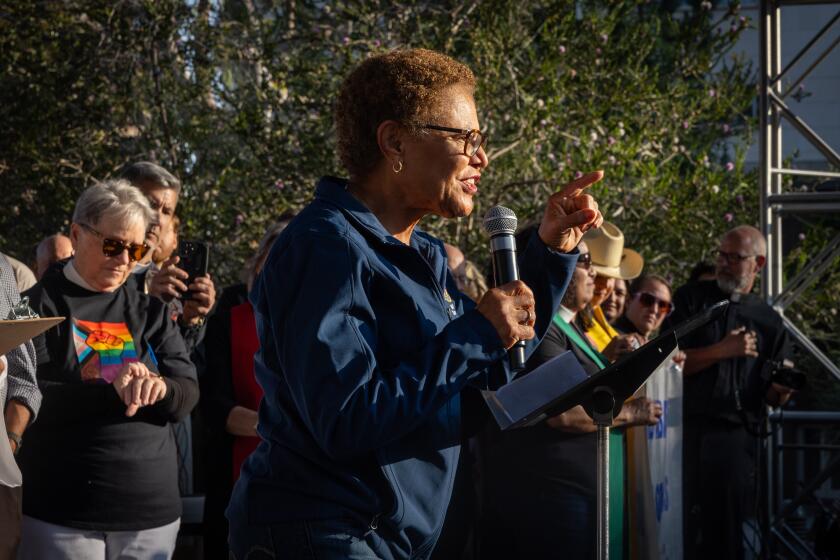Courts to Add Interpreters in Five More Languages
- Share via
In a striking sign of California’s changing demographics, the state Judicial Council announced Tuesday that it is adding five languages to California’s court interpreter program--the first addition since 1993.
The languages are Armenian, Cambodian, Mandarin Chinese, Russian and Punjabi.
Because of a shortage of interpreters, 3,500 court proceedings were delayed in each of the last two fiscal years, said Joseph Wong, a senior analyst with the administrative office of the courts in San Francisco.
To begin addressing that problem, the judges want to increase the number of certified court interpreters in the state from 1,108 to 1,300 by June.
The expansion “will help ensure equal access to justice in the California courts,” said Chief Justice Ronald M. George. “Everyone is entitled to due process in the courts, and a strong interpreters program is critical in a state as diverse as California.”
The announcement was accompanied by a study showing that more than 4% of California’s 33.4 million residents speak no English at all and that 224 languages are spoken in the state. A language other than English is spoken in almost half the households in Los Angeles County and about a quarter of the homes in Orange County, according to Census figures.
In 1980, the percentage of people 5 and older who spoke a language other than English at home was 31.4% in Los Angeles County; in 1990, that figure went up to 45.4%. In Orange County, the percentage went from 17.8% in 1980 to 31% in 1990.
The chief justice said that 100 languages and dialects are now interpreted in California courts. “I think the judiciary is probably a microcosm of California in terms of language needs,” George added.
The need for interpreters is no surprise to Deputy Dist. Atty. Greg Dohi, who leads the Asian gang team in the hard-core gang division of the Los Angeles County district attorney’s office. In the courthouse in Alhambra, Superior Court cases have been known to “grind to a screeching halt” while court staff runs out, scrambling to find a Mandarin interpreter, he said.
“We use Cambodian interpreters all the time. We use Mandarin interpreters all the time. Both are in short supply,” Dohi said.
In the melting pot of Southern California, many cases require more than one interpreter.
In current proceedings involving the shooting of a student in front of Hoover High School in Glendale, one of the defendants, Karen Terteryan, has been using a court-appointed Armenian interpreter, while the family of the slain victim, Raul Aguirre, has a Spanish interpreter, said Deputy Dist. Atty. Steven Lopez.
A few years ago, Lopez had a Hollywood robbery case with witnesses and victims who together required interpreters for six languages--Spanish, Cambodian, Punjabi, Lebanese Arabic, Egyptian Arabic and Tagalog, a language widely used in the Philippines.
The number of court proceedings needing interpreters is expected to increase by 13.5% by 2005 and to continue to escalate for the next 20 years, Wong said.
Of the state’s 58 counties, 56 provide interpreter services, with Los Angeles being the heaviest user. Trinity and Sierra counties, both in the far northern part of the state, are the only exceptions.
Victor E. Chavez, presiding judge of Los Angeles Superior Court, said he was delighted with the addition of languages.
“It certainly will standardize the quality” of court interpreters for those languages, Chavez said.
“The primary thing we want is to understand those who are testifying in court,” Chavez said. The better the interpreters, the more likely there’ll be just outcomes, he added.
There are now eight designated languages for which a court interpreter may be certified by the council: Arabic, Cantonese, Japanese, Korean, Portuguese, Spanish, Tagalog and Vietnamese.
Spanish interpretation services were used far and away the most--145,661 interpreter-days in the 1998-99 fiscal year, an 18.9% increase from five years ago. Vietnamese was a distant second at 9,197 interpreter-days. The others in the top 10 were Korean, 3,716; Cantonese, 3,252; Armenian, 2,730; Cambodian, 2,112; Mandarin, 2,100; Tagalog, 1,986; Russian, 1,956; and Punjabi, 1,492.
On the other hand, the breadth of the Punjabi population in California was reflected by the fact that 37 counties provided interpreter services in Punjabi, second most in the state after Spanish. All 56 counties that have interpreter services provide Spanish.
The Judicial Council has recommended that three criteria be used in designating new languages for interpreter certification: Use of the language should be substantial, increasing or relatively stable, and involving a migration trend that is likely to continue.
The designations are intended to build a bigger base of people certified to interpret those languages to meet the courts’ needs.
The council is recruiting interpreters in all languages but is particularly looking for speakers of Spanish, Vietnamese, Korean, Armenian, Cantonese, Farsi/Persian, Tagalog, Cambodian, Laotian, Mandarin, Arabic, Hmong, Punjabi, Russian and Japanese, said William C. Vickrey, the administrative director of the California Courts.
Tuesday’s study said use of interpreters for some languages, including Persian, Thai and Urdu, has been decreasing. The study suggested that the decline could stem from increased English proficiency among immigrant communities, less contact with the court system as a result of “improved socioeconomic status” or a decline in the number of immigrants as a result of people moving out of state.
Vickrey said the council also has collaborated with schools and universities to create more educational opportunities for those interested in becoming interpreters, who now earn $265 a day when paid by the courts and often far more in private-sector engagements. The pay has gone up three times in 18 months, and George plans to ask the state Legislature for another increase of $20 a day.
(BEGIN TEXT OF INFOBOX / INFOGRAPHIC)
Justice in Many Languages
Five languages have been added to California’s court interpreter
program: Armenian, Cambodian, Mandarin Chinese, Russian and Punjabi. Here are the numbers of interpreter service days worked per language. An interpreter service day means an interpreter working a full court day.
Source: California Judicial Council
More to Read
Sign up for Essential California
The most important California stories and recommendations in your inbox every morning.
You may occasionally receive promotional content from the Los Angeles Times.












